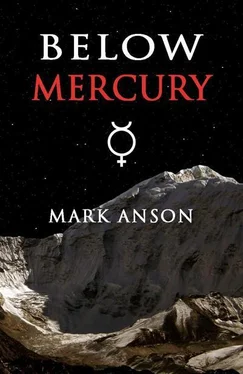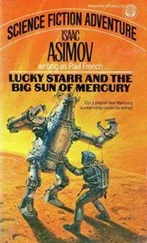‘Make sure your visor is on automatic,’ Abrams warned, ‘and don’t look at the Sun when we get out there.’
‘Okay,’ Elliott said, his breath sounding rasping and hollow in his helmet. He checked the wrist console on his suit, and followed Abrams up the ramp, the robot following behind. Its lumbering gait was strangely silent in the vacuum.
The rock walls on either side fell away as they came to the top of the ramp, and suddenly their heads and upper bodies emerged out of shadow and into the brilliant glare of the Sun.
‘Whoah.’ Abrams let out an involuntary cry of surprise as the sunlight smote him in the face. Even at Mercury’s South Pole, the Sun’s radiant energy was intense; it was like walking from an air-conditioned lobby into the full heat of a tropical day. His helmet visor darkened instantly at the first touch of sunlight, and the suit’s cooling unit increased power to compensate for the sudden inrush of heat.
Elliott came up and stood beside him, and surveyed the scene. The robot halted behind them.
‘Jesus.’
They had emerged from the cutting to stand on a levelled area high on Chao Meng-fu’s ramparts, on the spur that thrust out into the crater. A lightweight post-and-wire guard fence ran around the perimeter of the area. Ahead to their left, the Sun glared over the southern peaks of Chao Meng-fu’s crater wall, a mass of terraces, boulder slopes and hills that climbed up into the black sky.
On their right, northwest, a sheer fall plunged into blackness, and an array of repeater antennas pointed down into the crater, providing infill coverage for the radio shadow behind the crater walls. Feeder bundles from the antenna array snaked across the rock into large junction boxes, and from one of these boxes, a set of heavy cables led off alongside a sloping pathway to the left. It wound its way up into the higher peaks, hugging the shadows.
Abrams and Elliott walked over to the right-hand edge and looked out across the crater. From this high vantage point, they could see almost the entire ring of the crater wall. In the sharp relief of the low sunlight, the encircling peaks looked like a ring of small, broken teeth.
Standing there above the sheer drop, they had the impression that they were staring out over a gigantic, bottomless pit, a gateway to a hidden underworld. Only the central peaks broke the illusion; they rose into the sky in the distance, rising up out of nothingness, their steep-sided peaks blazing in the sunlight above the blackness of the crater floor. No trace of the crater floor could be made out; the sunlight reduced the landscape to a world of stark whites and absolute blacks.
‘That’s one fantastic view,’ Abrams commented, following the line of peaks round with his eyes. Elliott didn’t reply; words seemed superfluous as he gazed out over the spectacular scene.
The two men remained there for long moments, taking in the forbidding majesty of Mercury’s landscape.
‘Better get moving,’ Abrams said at last, tearing himself away from the view. He turned to the antenna array. ‘I guess we can’t use any of these?’
‘No, we’re still too low on the mountainside, and these are too small to reach Earth anyway.’ Elliott reached up and prodded one of the VHF antennas. It shook at his touch.
‘Yeah, I knew it couldn’t be that easy,’ Abrams said, and looked up the pathway that led off into the peaks. ‘That looks like one hell of a climb.’
As their eyes became used to the bright sunlight, they saw that the mountainside was not white, but only appeared so in the intense sunlight. In the shade, the exposed rocks were a mixture of charcoal and paler grey, the shattered basalt and breccia of the crater walls. Here and there, an occasional sparkle came from lumps of ancient anorthosite, blown out of the crater by the colossal impact that formed it. Everything was layered thickly with the pulverised soil and dust of billions of years of meteorite impacts, rounding the rough edges of the rocks and boulders, like grey snow on the landscape.
Abrams set off towards the path, Elliott and the robot behind him.
The path had been cut into the solid rock, like the flat area they had just left. It went upwards at a steep grade, but in the low gravity, it was very like walking back on Earth. They walked steadily, being careful not to over-exert themselves and cause their visors to mist over. The path snaked its way through the rising, tumbled terrain towards the unseen peaks, favouring a route that gave greatest shade from the Sun.
The cable bundles from the repeater station followed the path as it climbed upwards. The cables ran between supports set at regular intervals by the side of the path, but in several places where the path twisted and turned through the tumbled boulders, the cable leapt away from the path on a route of its own, reappearing besides them a short distance further on.
After they had been climbing for about thirty minutes, they plunged into the deep shadow of a hollow in the mountainside. A sign by the side of the path announced:
HALF WAY TO PEAK
HEIGHT ABOVE ICE FIELD: 3,150 m
Elliott and Abrams took a breather in the cool darkness. The robot halted beside them.
‘How’s your air?’ Elliott asked. His face, which had been invisible behind his darkened visor, gradually emerged as the visor adjusted to the shadow.
Abrams studied his wrist console. ‘Got just over two hours left at present usage. You?’
‘The same. We’ll use less once we’ve stopped climbing, but we’re likely to need a cylinder change on the way back.’
‘I think you’re right. It’s nearly thirteen hundred hours. I’m going to try to contact the others.’ Abrams used his wrist console to select the comlink, but after a few moments, he shook his head, and started to tap out a message on the console. ‘No coverage here. I’ll send a text to go later.’
They rested for a few more minutes, letting their suit temperatures stabilise after the exertion of the climb, and then set out again on the final stage of their journey.
They rounded the hillside above the hollow that they had rested in, and found themselves at the bottom of a wide boulder slope that ran upwards towards a pass between two peaks. The Sun blazed down on the sloping plain from above the hills on the left as the path swung to the right and headed up towards the high pass.
Abrams and Elliott toiled up the path, followed by the armoured bulk of the robot. There were few shadows on the sun-baked plain to offer any respite from the Sun, and they had to keep on stopping at regular intervals in the shade of one of the larger boulders, to avoid overheating.
They spoke little on the long climb upwards. It was further than it looked; it was difficult to judge distances and angles in the oblique lighting, and the slope seemed to unroll endlessly before them. By the time of their third rest, however, they could look down and see that they had come up a long way.
The tumbled peaks fell away below them; from this vantage point, they appeared less sharp-edged; a landscape of rolling hills that disappeared towards the unseen edge of the crater. The long slope that they had climbed was a shallow fault that cut across the folds of the terrain, a remnant of some ancient slumping of the mountain walls after the impact of the huge meteorite.
‘Not far now,’ Abrams said, ‘one last push and I think we’ll be able to see the main antenna.’
They turned their backs on the view behind them and continued upwards, and now the high pass seemed much closer. The path climbed very steeply now, and in places, it was cut into broad, shallow stairs to allow robots to ascend. They plunged into cool shadow again as the walls of the pass rose above them; they were steep-sided, as if some giant knife had cut the hills in half. As they tramped up another flight of steps, Abrams looked up.
Читать дальше











